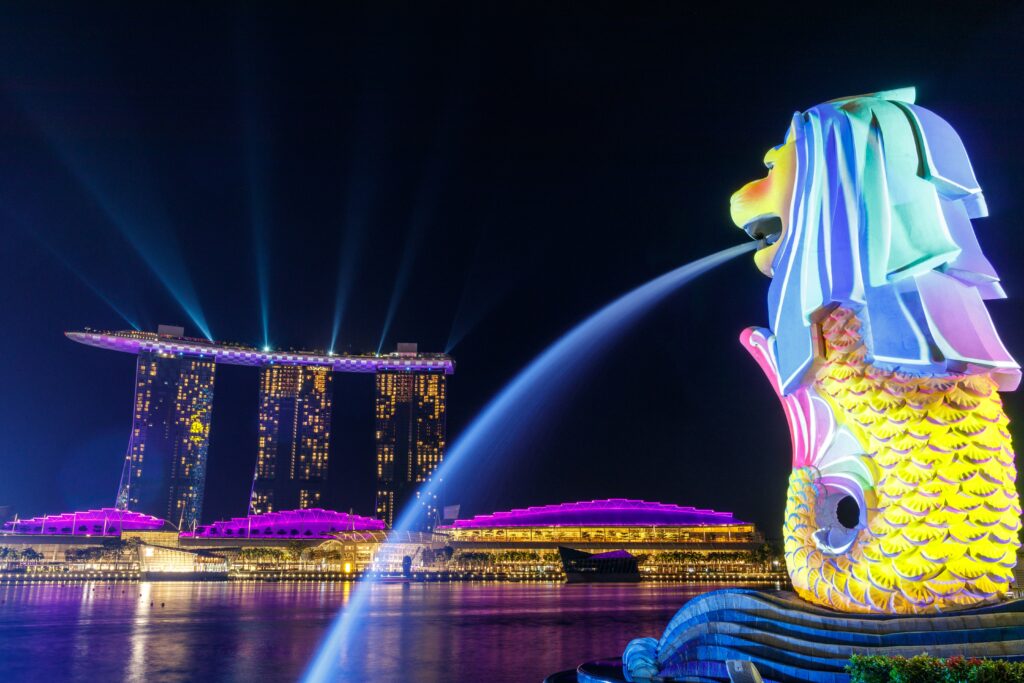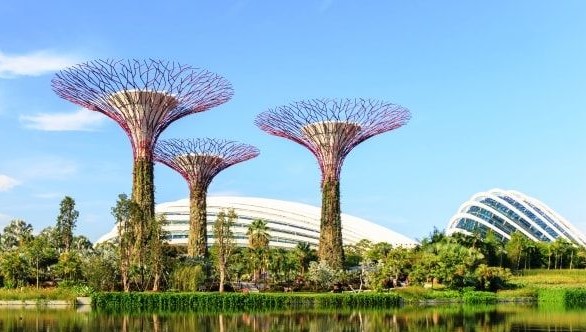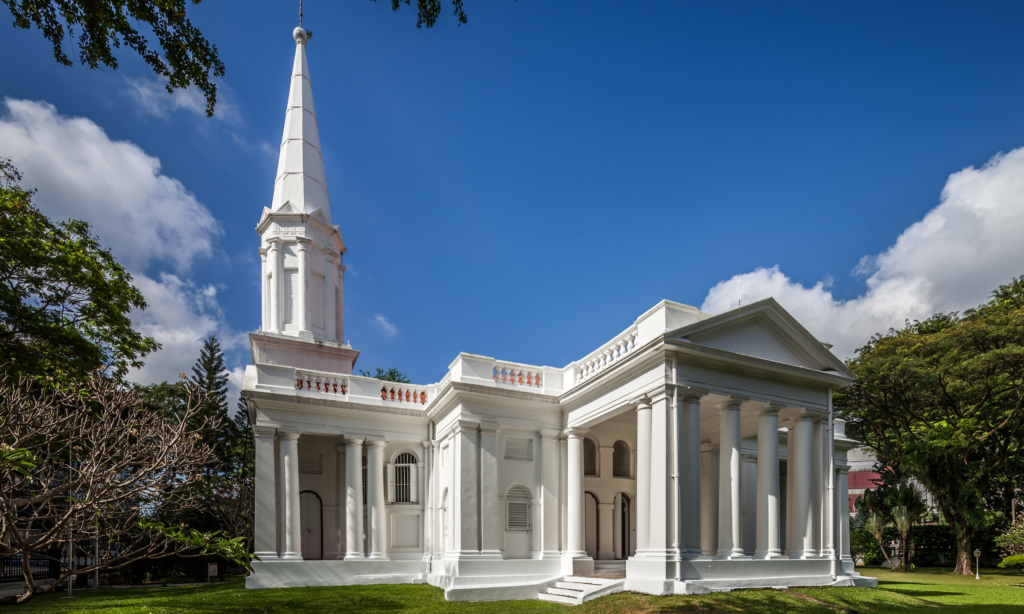The merlion is a mythical creature with the head of a lion and the body of a fish. It became the logo for the Singapore tourism board in 1966. Singapore – Singapura means ‘lion city’ in Malay, hence the lion head. The fish body represents Singapore’s origin as a Javaense fishing village, Temasek.

Singapore is – as you doubtless know – a heavily populated island at the southern tip of the Malay Peninsula, about 85 miles north of the Equator. It consists of Singapore Island and about 60 small islets. Johor Strait divides the main island from the peninsular of Malaysia, but there is a bridge. Singapore is a city state and the largest port in Southeast Asia and one of the busiest in the world. It dominates the Strait of Malacca, which connects the Indian Ocean to the South China Sea. Once a tiny fishing village, then a British colony, it is now an independent state and a member of the Commonwealth. It is also multicultural, with four official languages: English, Malay, Mandarin, and Tamil. As English is the common language, this makes it one of the easiest corners of Asia for the English-only speaking traveller. Add tidy, clean, efficient, friendly (mostly) and surprisingly green, and it compares with few other Asian cities I have visited.
Given its proximity to the equator, and the fact that it claims to rain somewhere on the island every day, it is hot and humid. Cloud cover does keep the temperature a tad lower, but as that generally sits at about 26 degrees centigrade, with 100% humidity, low becomes a relative term. However, the last weeks in South Australia have been unseasonably chilly, so I’m not complaining.
It is also one of the most expensive cities in the region. We are only passing through (a brief break on the long haul to London), so we are happy to live on fried rice, noodle soup and margaritas – the drink not the pizza – for a couple of days.
It’s been eight years since we last visited Singapore. Where has the time gone? Last time we flew in from Manila and stayed on the East Coast Road. This time we are a hop-skip-and-a-jump from Bugis MRT, on the doorstep of Kampong Glam.
Kampong Glam is a tiny neighbourhood of nineteenth century shop houses that has been a focal point for the Muslim community since the 1800s, when Sir Stamford Raffles allocated the area to the Malay, Arab and Bugis communities. It abuts a magnificent mosque, built in 1824 by the first sultan of Singapore Hussein Shah. Shops selling textiles and carpets abound, mixed up with bars and restaurants serving almost any cuisine you can imagine. And, instead of Melbourne’s ubiquitous and generally ugly graffiti, there is colourful street art on every available wall. Although still popular with the Muslim community, the area has evolved into a trendy haunt for travellers and art lovers.
‘Kampong’ means ‘compound’ in Malay. ‘Gelam’ is a long-leaved paperbark tree, once commonly found in the area and used for boat-making, medicine and even as a seasoning for food. Thanks, Google! We knew none of this when we booked the hotel, but we found ourselves wandering down Arab Street and Haji Lane in search of Chinese noodles, and ending up with Turkish dips and margaritas at Pashas. The following night it was Blue Jazz for more margaritas, satays and the most delicious, most enormous, and most exorbitant slab of pizza I have ever eaten. In the mornings, for breakfast, we found a lovely little café called ‘All Things Delicious’ where the staff were sweet, as were the cakes, and we could drink excellent coffee.
Friends who had also visited Singapore recently recommended a visit to The Gardens by the Bay, which cover over 100 hectares of reclaimed land along the waterfront. You can pay to visit the two conservatories – the Flower Dome and Cloud Forest – but there is no charge to wander at will around the grounds. In our dry desert state, the Bicentennial Conservatory at the Botanic Gardens first introduced me to the concept of humidity. I assumed that’s what a conservatory was for, but the Flower Dome in Singapore replicates our own cool, Mediterranean climate. And the Cloud Forest conservatory replicates tropical mountain regions.
Then there are the Super Trees. I was expecting Californian Redwoods or something similar. Instead, they are vertical gardens of metal, shaped like the trunk and canopy of trees. A walkway between two such ‘trees’ provides an aerial view of the park. Unfortunately, we only had an afternoon free, but it was enough time to circle round the park, admiring the lush, tropical flora and the interesting sculptures hidden among the foliage. We also found Satay by the Bay, an outdoor Hawkers corner with an array of Asian food for lunch. (Fried rice, but no margaritas.)
Singapore is a wonderfully clean and efficient city, easy to get around on foot or by rail. The shopping venues and restaurants are prolific, and strangely in this consumer Mecca, so are the churches. We popped into the oldest church in Singapore, the Armenian Church of Saint Gregory the Illuminator, small, round and simple, Neoclassical and entirely cloaked in white, like a bride. By coincidence, a wedding had obviously taken place that morning, the bride and her family still milling about on the lawn. Just down the road is the Anglican Cathedral of St. Andrew’s, named in honour of the Scottish – presumably Presbyterian – community which donated generously to the building fund, and is full of plaques dedicated to colonial inhabitants of the past century.
A quick visit to the Art Gallery, for the world’s most expensive coffee, and our time was up. Thanks for having us, Singapore. It was lovely to catch up again…
*Photo of the Singa Lion by Joshua Ang on Unsplash – thank you! And with thanks to Google for the rest.



